TOYOTA RAV4 PLUG-IN HYBRID 2023 Owners Manual
Manufacturer: TOYOTA, Model Year: 2023, Model line: RAV4 PLUG-IN HYBRID, Model: TOYOTA RAV4 PLUG-IN HYBRID 2023Pages: 718, PDF Size: 167.55 MB
Page 461 of 718
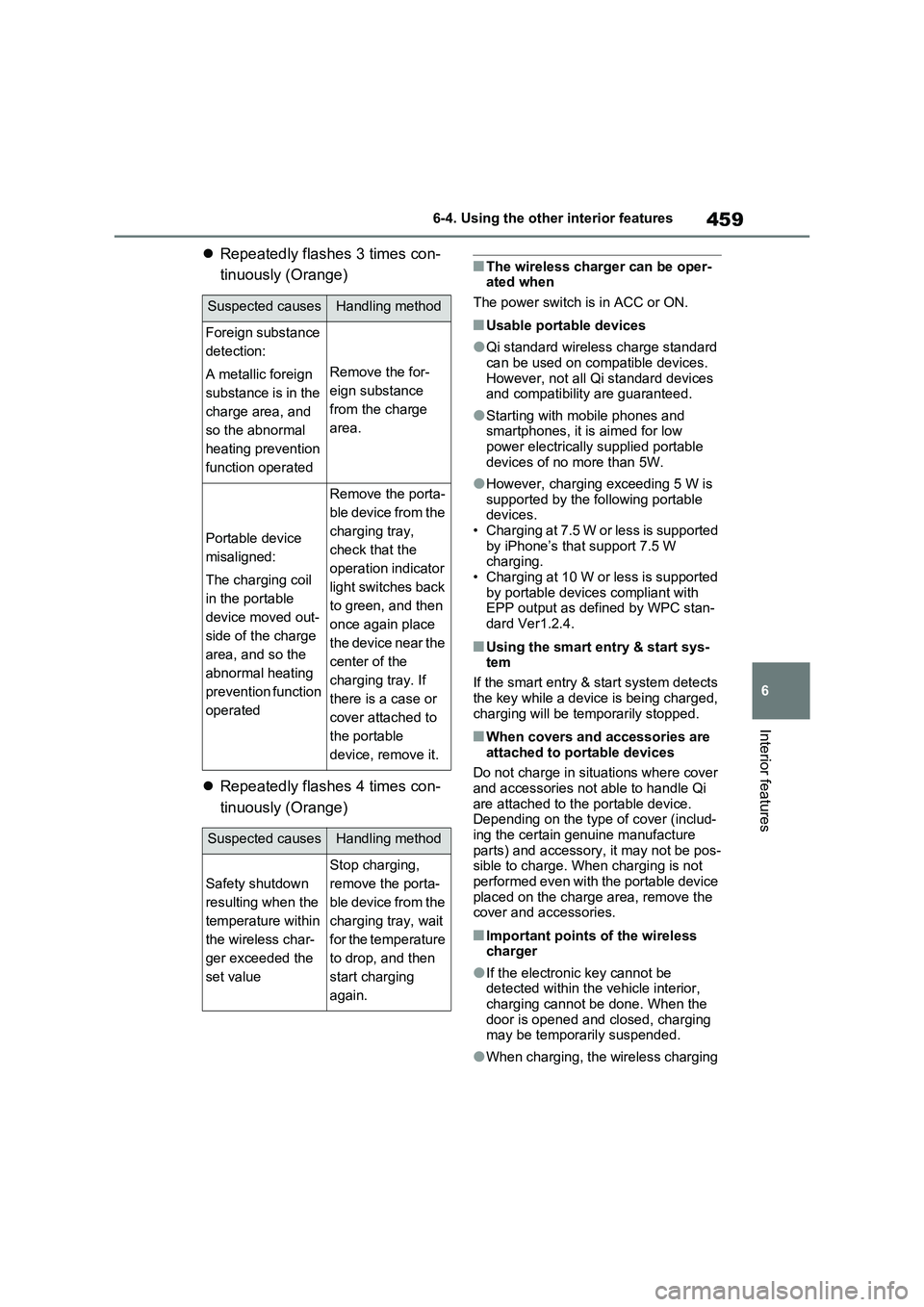
459
6 6-4. Using the other interior features
Interior features
Repeatedly flashes 3 times con-
tinuously (Orange)
Repeatedly flashes 4 times con-
tinuously (Orange)■The wireless charger can be oper-
ated when
The power switch is in ACC or ON.
■Usable portable devices
●Qi standard wireless charge standard
can be used on compatible devices.
However, not all Qi standard devices
and compatibility are guaranteed.
●Starting with mobile phones and
smartphones, it is aimed for low
power electrically supplied portable
devices of no more than 5W.
●However, charging exceeding 5 W is
supported by the following portable
devices.
• Charging at 7.5 W or less is supported
by iPhone’s that support 7.5 W
charging.
• Charging at 10 W or less is supported
by portable devices compliant with
EPP output as defined by WPC stan-
dard Ver1.2.4.
■Using the smart entry & start sys-
tem
If the smart entry & start system detects
the key while a device is being charged,
charging will be temporarily stopped.
■When covers and accessories are
attached to portable devices
Do not charge in situations where cover
and accessories not able to handle Qi
are attached to the portable device.
Depending on the type of cover (includ-
ing the certain genuine manufacture
parts) and accessory, it may not be pos-
sible to charge. When charging is not
performed even with the portable device
placed on the charge area, remove the
cover and accessories.
■Important points of the wireless
charger
●If the electronic key cannot be
detected within the vehicle interior,
charging cannot be done. When the
door is opened and closed, charging
may be temporarily suspended.
●When charging, the wireless charging
Suspected causesHandling method
Foreign substance
detection:
A metallic foreign
substance is in the
charge area, and
so the abnormal
heating prevention
function operated
Remove the for-
eign substance
from the charge
area.
Portable device
misaligned:
The charging coil
in the portable
device moved out-
side of the charge
area, and so the
abnormal heating
prevention function
operated
Remove the porta-
ble device from the
charging tray,
check that the
operation indicator
light switches back
to green, and then
once again place
the device near the
center of the
charging tray. If
there is a case or
cover attached to
the portable
device, remove it.
Suspected causesHandling method
Safety shutdown
resulting when the
temperature within
the wireless char-
ger exceeded the
set value
Stop charging,
remove the porta-
ble device from the
charging tray, wait
for the temperature
to drop, and then
start charging
again.
Page 462 of 718
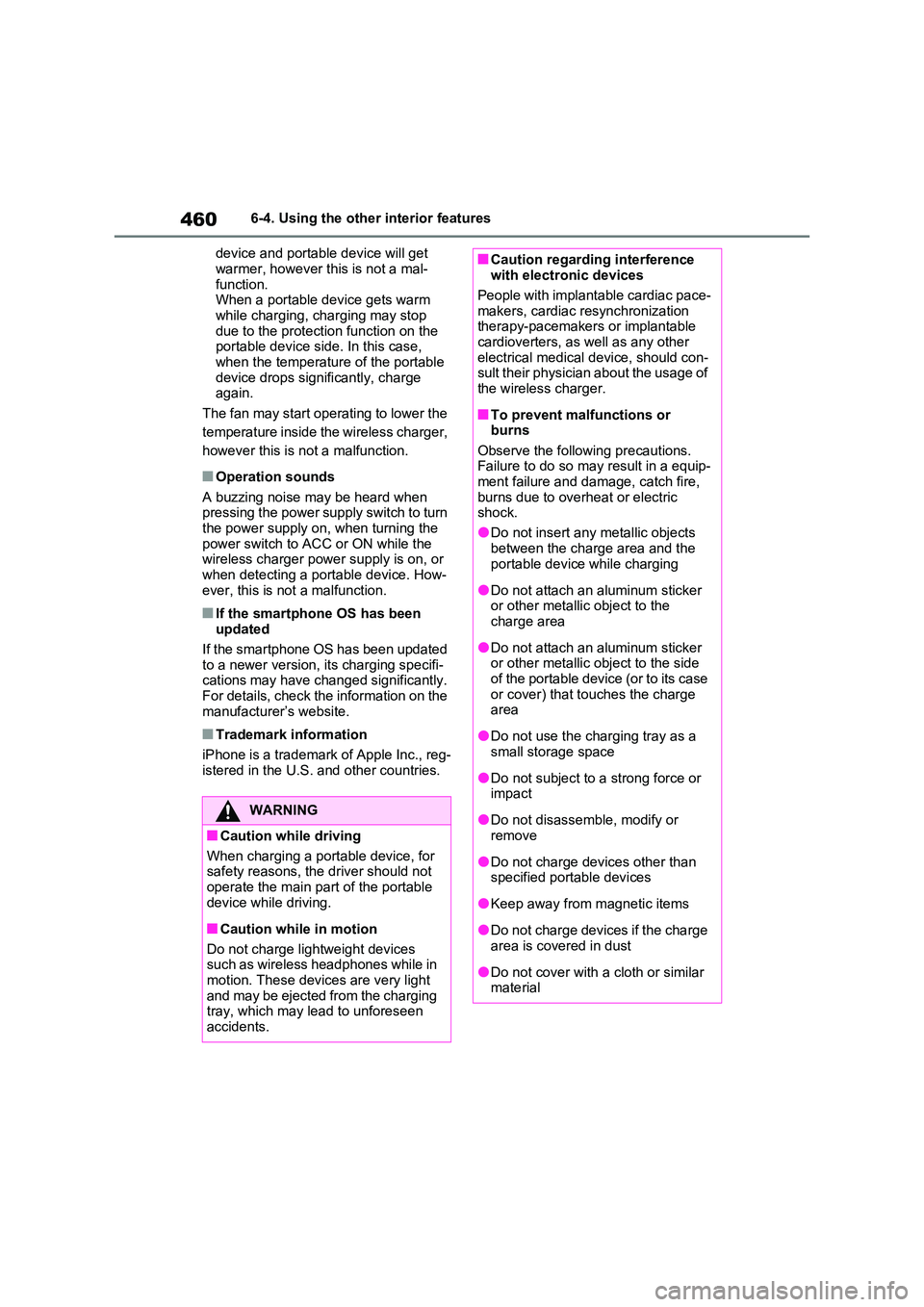
4606-4. Using the other interior features
device and portable device will get
warmer, however this is not a mal- function.When a portable device gets warm
while charging, charging may stop due to the protection function on the portable device side. In this case,
when the temperature of the portable device drops significantly, charge again.
The fan may start operating to lower the
temperature inside the wireless charger,
however this is not a malfunction.
■Operation sounds
A buzzing noise may be heard when pressing the power supply switch to turn the power supply on, when turning the
power switch to ACC or ON while the wireless charger power supply is on, or when detecting a portable device. How-
ever, this is not a malfunction.
■If the smartphone OS has been updated
If the smartphone OS has been updated
to a newer version, its charging specifi- cations may have changed significantly. For details, check the information on the
manufacturer’s website.
■Trademark information
iPhone is a trademark of Apple Inc., reg- istered in the U.S. and other countries.
WARNING
■Caution while driving
When charging a portable device, for safety reasons, the driver should not
operate the main part of the portable device while driving.
■Caution while in motion
Do not charge lightweight devices such as wireless headphones while in
motion. These devices are very light and may be ejected from the charging tray, which may lead to unforeseen
accidents.
■Caution regarding interference with electronic devices
People with implantable cardiac pace-
makers, cardiac resynchronization therapy-pacemakers or implantable cardioverters, as well as any other
electrical medical device, should con- sult their physician about the usage of the wireless charger.
■To prevent malfunctions or burns
Observe the following precautions. Failure to do so may result in a equip-ment failure and damage, catch fire,
burns due to overheat or electric shock.
●Do not insert any metallic objects
between the charge area and the portable device while charging
●Do not attach an aluminum sticker or other metallic object to the charge area
●Do not attach an aluminum sticker or other metallic object to the side
of the portable device (or to its case or cover) that touches the charge area
●Do not use the charging tray as a small storage space
●Do not subject to a strong force or impact
●Do not disassemble, modify or remove
●Do not charge devices other than specified portable devices
●Keep away from magnetic items
●Do not charge devices if the charge area is covered in dust
●Do not cover with a cloth or similar material
Page 463 of 718
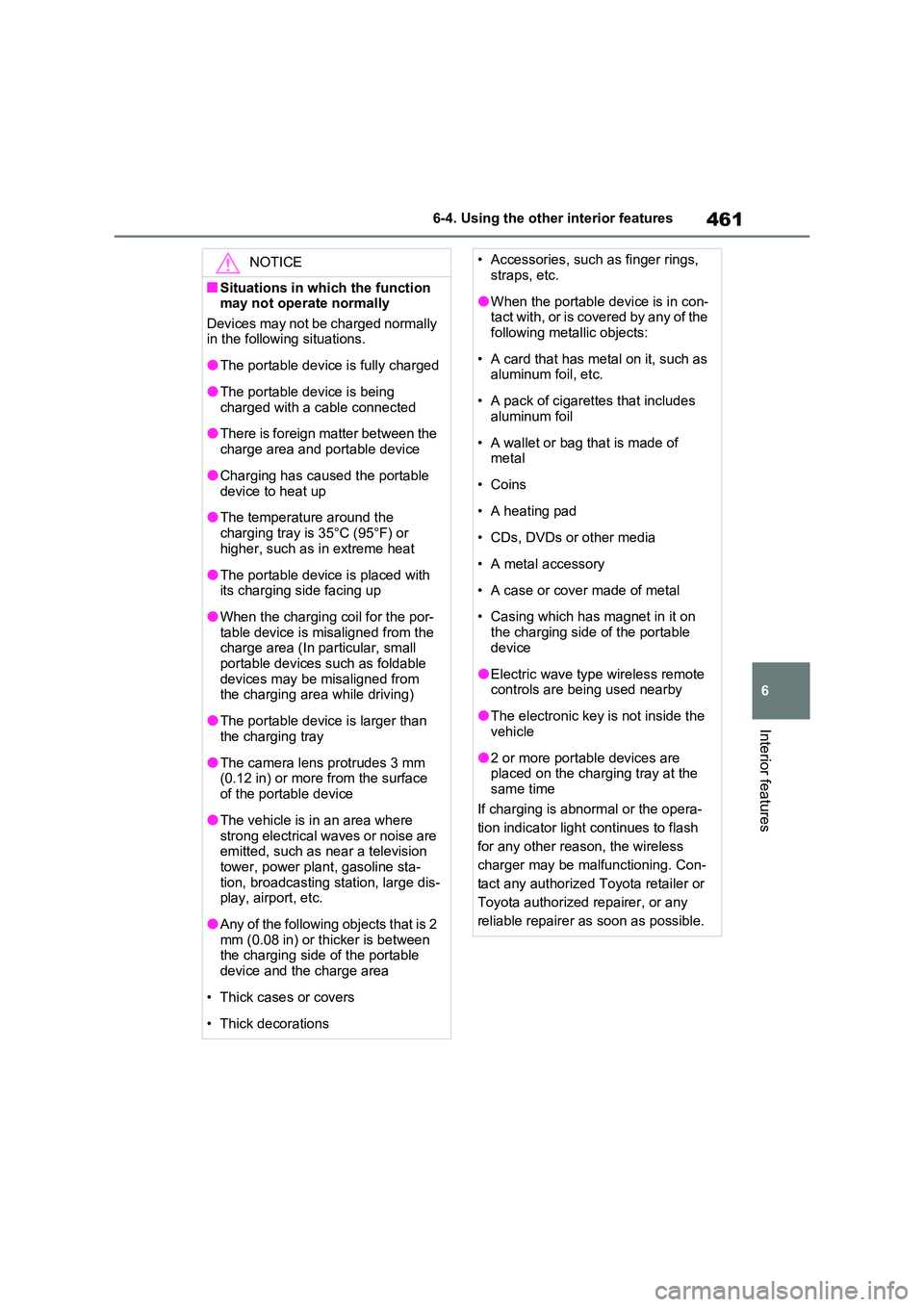
461
6
6-4. Using the other interior features
Interior features
NOTICE
■Situations in which the function may not operate normally
Devices may not be charged normally in the following situations.
●The portable device is fully charged
●The portable device is being
charged with a cable connected
●There is foreign matter between the
charge area and portable device
●Charging has caused the portable
device to heat up
●The temperature around the
charging tray is 35°C (95°F) or higher, such as in extreme heat
●The portable device is placed with its charging side facing up
●When the charging coil for the por-table device is misaligned from the charge area (In particular, small
portable devices such as foldable devices may be misaligned from the charging area while driving)
●The portable device is larger than the charging tray
●The camera lens protrudes 3 mm (0.12 in) or more from the surface
of the portable device
●The vehicle is in an area where
strong electrical waves or noise are emitted, such as near a television tower, power plant, gasoline sta-
tion, broadcasting station, large dis- play, airport, etc.
●Any of the following objects that is 2 mm (0.08 in) or thicker is between the charging side of the portable
device and the charge area
• Thick cases or covers
• Thick decorations
• Accessories, such as finger rings, straps, etc.
●When the portable device is in con-tact with, or is covered by any of the following metallic objects:
• A card that has metal on it, such as aluminum foil, etc.
• A pack of cigarettes that includes aluminum foil
• A wallet or bag that is made of metal
•Coins
• A heating pad
• CDs, DVDs or other media
• A metal accessory
• A case or cover made of metal
• Casing which has magnet in it on
the charging side of the portable device
●Electric wave type wireless remote controls are being used nearby
●The electronic key is not inside the vehicle
●2 or more portable devices are placed on the charging tray at the same time
If charging is abnormal or the opera-
tion indicator light continues to flash
for any other reason, the wireless
charger may be malfunctioning. Con-
tact any authorized Toyota retailer or
Toyota authorized repairer, or any
reliable repairer as soon as possible.
Page 464 of 718
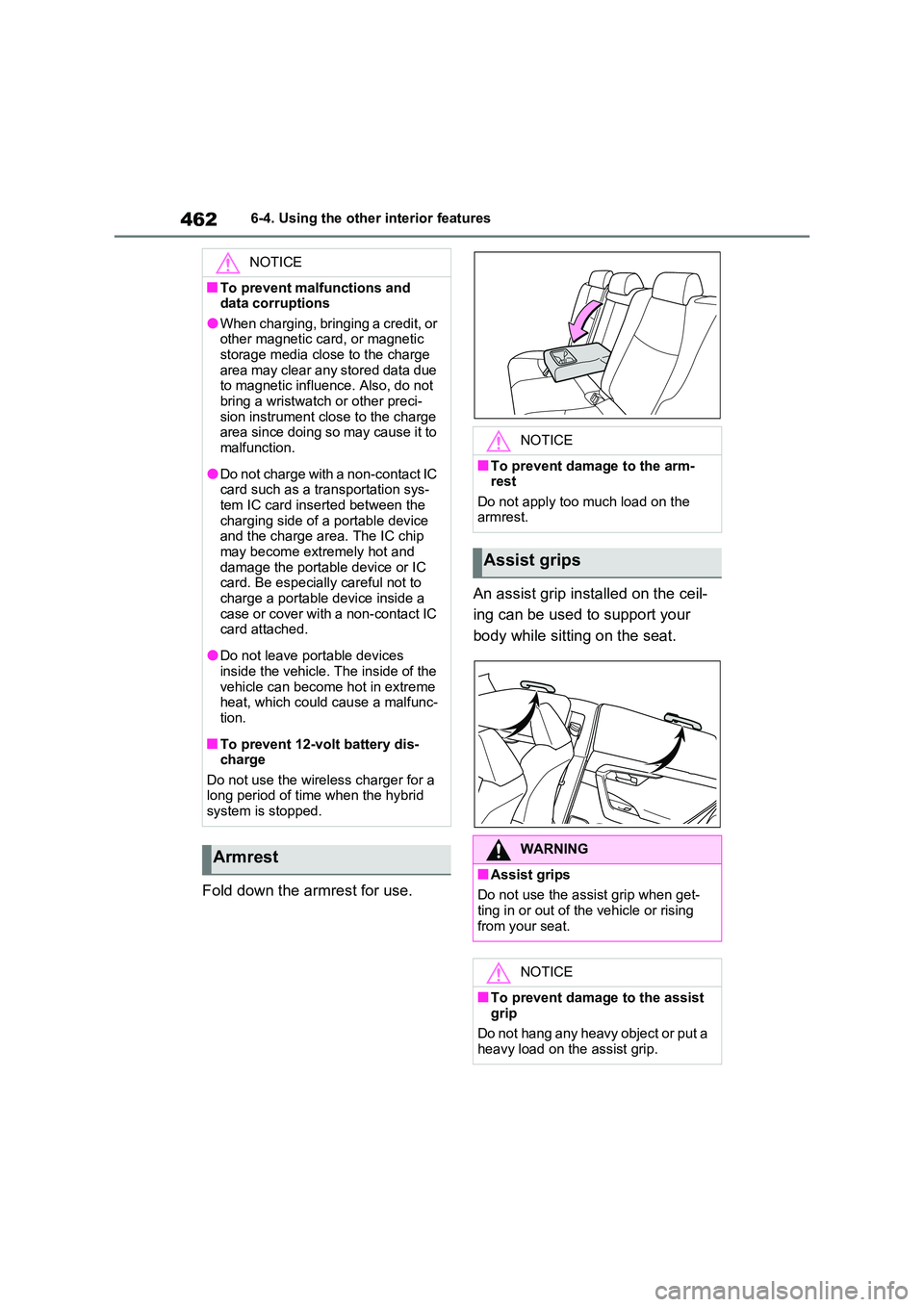
4626-4. Using the other interior features
Fold down the armrest for use.
An assist grip installed on the ceil-
ing can be used to support your
body while sitting on the seat.
NOTICE
■To prevent malfunctions and data corruptions
●When charging, bringing a credit, or other magnetic card, or magnetic storage media close to the charge
area may clear any stored data due to magnetic influence. Also, do not bring a wristwatch or other preci-
sion instrument close to the charge area since doing so may cause it to malfunction.
●Do not charge with a non-contact IC card such as a transportation sys-
tem IC card inserted between the charging side of a portable device and the charge area. The IC chip
may become extremely hot and damage the portable device or IC card. Be especially careful not to
charge a portable device inside a case or cover with a non-contact IC card attached.
●Do not leave portable devices inside the vehicle. The inside of the
vehicle can become hot in extreme heat, which could cause a malfunc-tion.
■To prevent 12-volt battery dis-charge
Do not use the wireless charger for a long period of time when the hybrid system is stopped.
Armrest
NOTICE
■To prevent damage to the arm-rest
Do not apply too much load on the armrest.
Assist grips
WARNING
■Assist grips
Do not use the assist grip when get-
ting in or out of the vehicle or rising from your seat.
NOTICE
■To prevent damage to the assist grip
Do not hang any heavy object or put a
heavy load on the assist grip.
Page 465 of 718
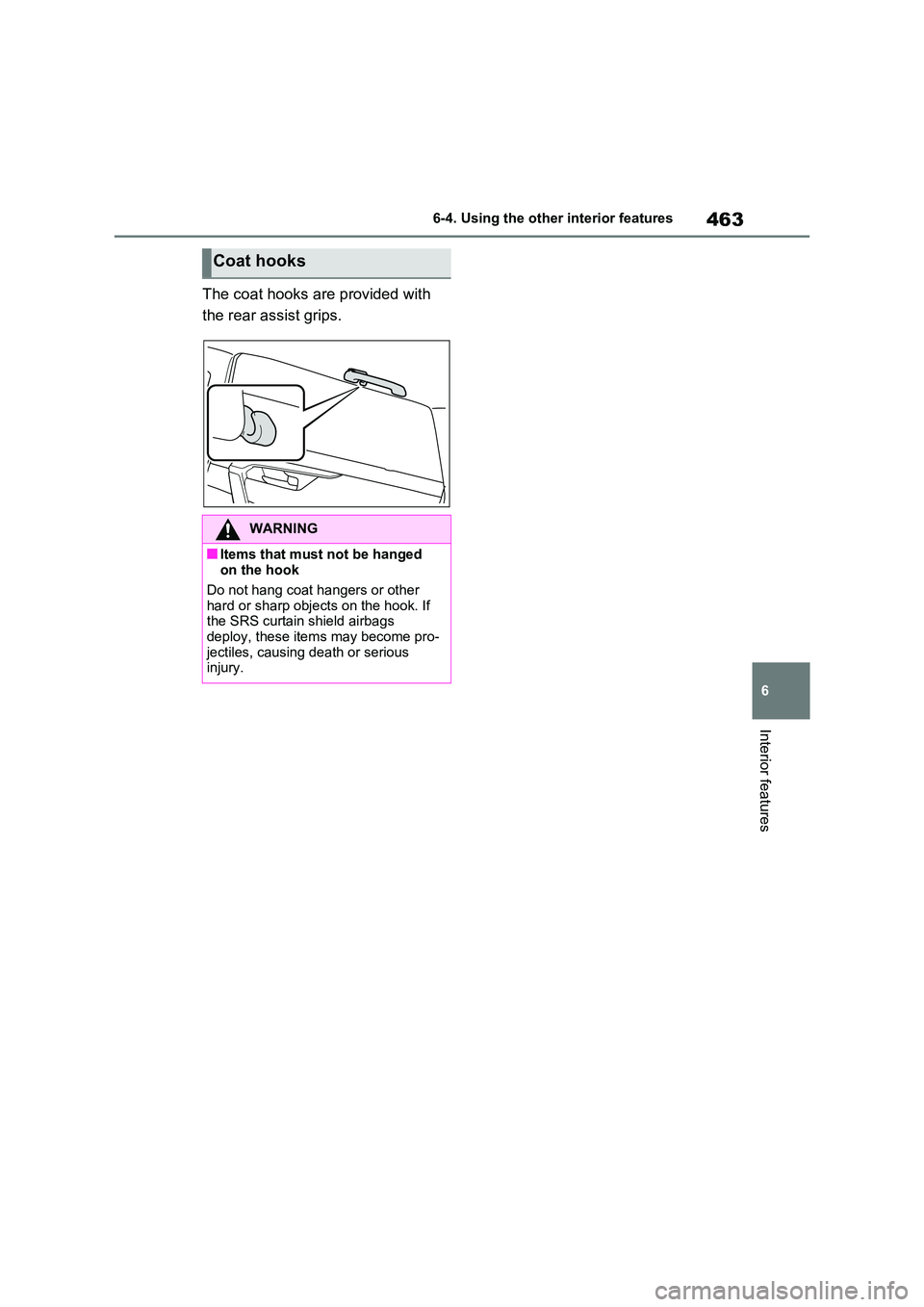
463
6
6-4. Using the other interior features
Interior features
The coat hooks are provided with
the rear assist grips.
Coat hooks
WARNING
■Items that must not be hanged on the hook
Do not hang coat hangers or other hard or sharp objects on the hook. If the SRS curtain shield airbags
deploy, these items may become pro- jectiles, causing death or serious injury.
Page 466 of 718
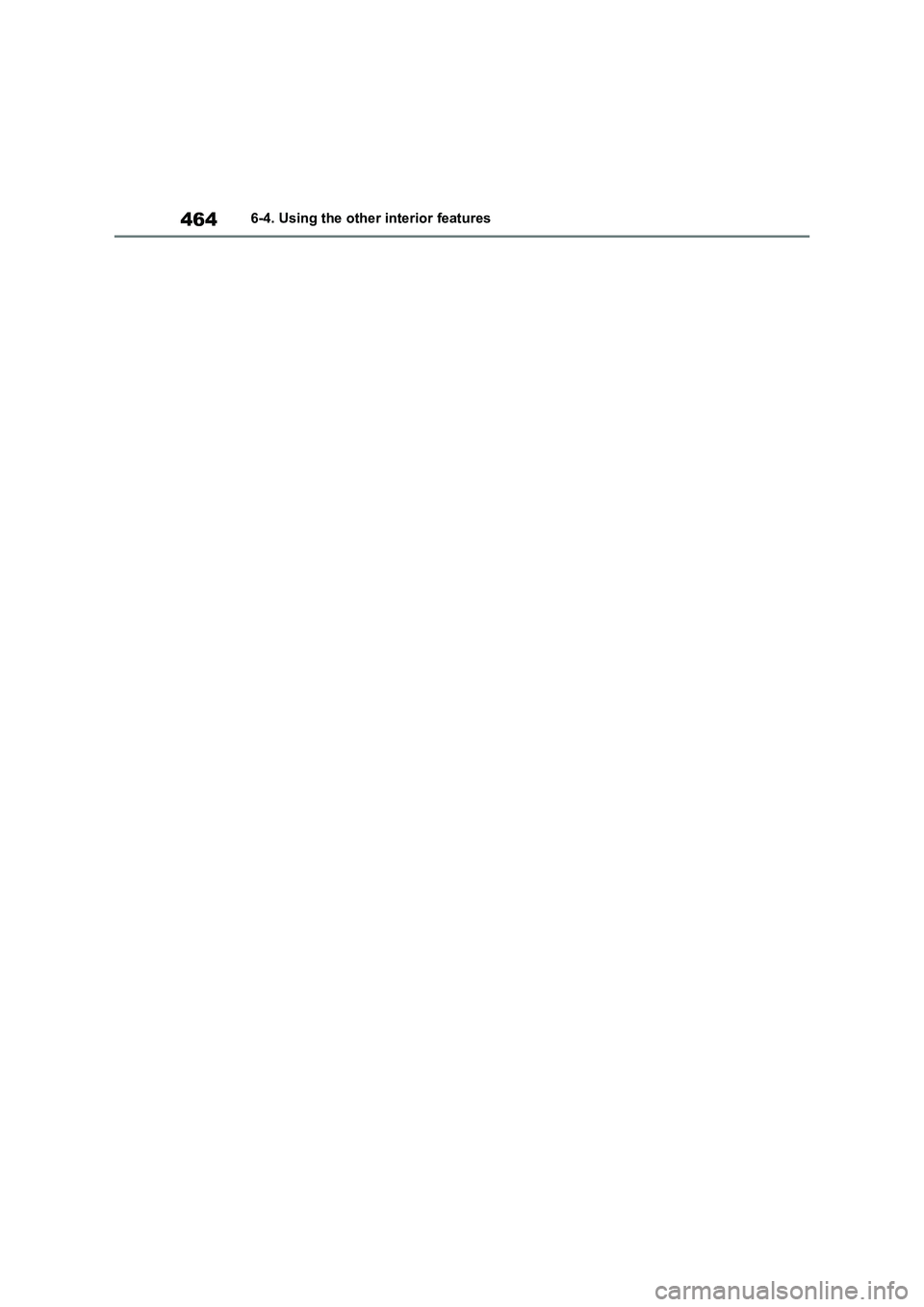
4646-4. Using the other interior features
Page 467 of 718
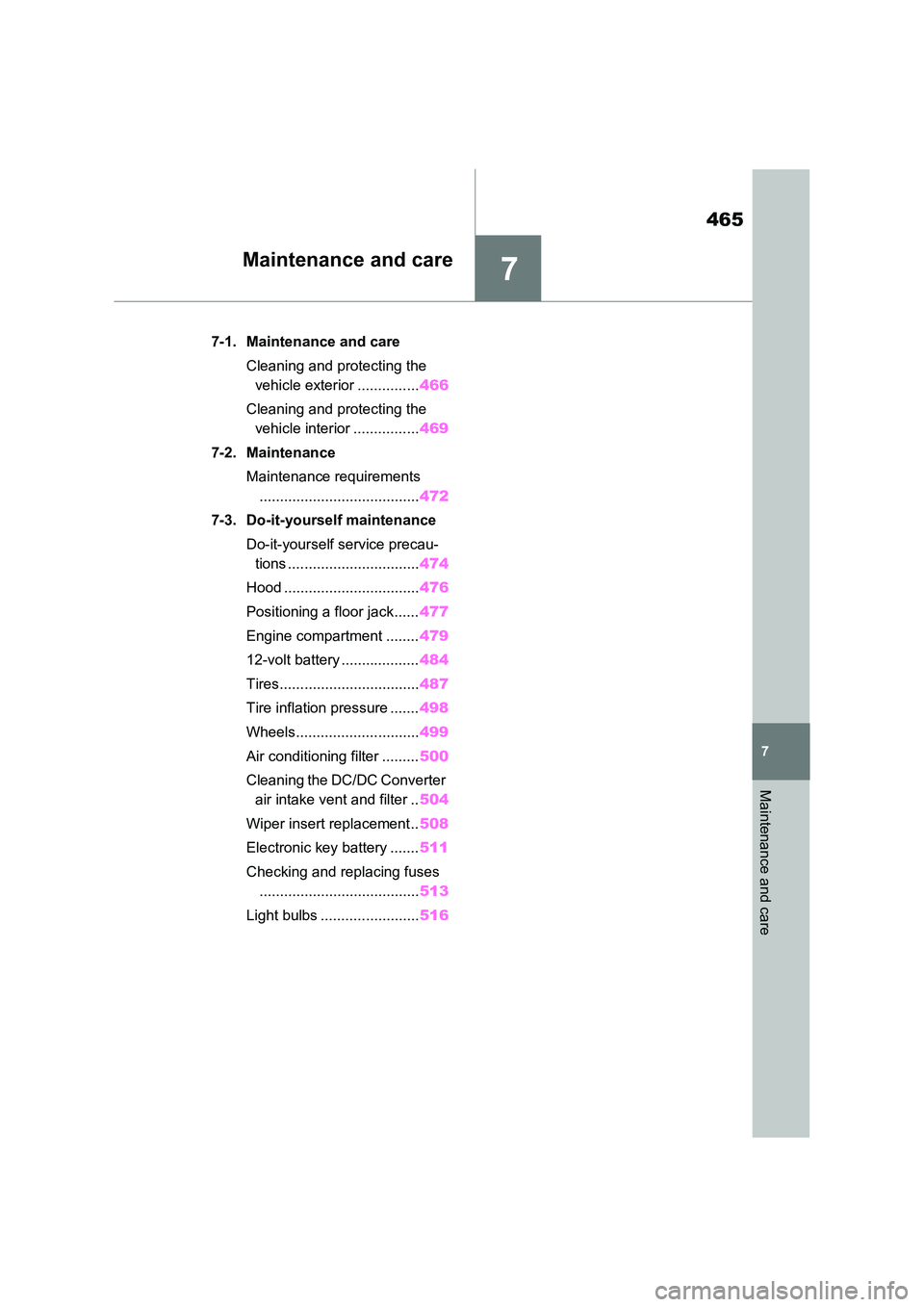
7
465
7
Maintenance and care
Maintenance and care
7-1. Maintenance and care
Cleaning and protecting the
vehicle exterior ............... 466
Cleaning and protecting the
vehicle interior ................ 469
7-2. Maintenance
Maintenance requirements
....................................... 472
7-3. Do-it-yourself maintenance
Do-it-yourself service precau-
tions ................................ 474
Hood ................................. 476
Positioning a floor jack...... 477
Engine compartment ........ 479
12-volt battery ................... 484
Tires.................................. 487
Tire inflation pressure ....... 498
Wheels.............................. 499
Air conditioning filter ......... 500
Cleaning the DC/DC Converter
air intake vent and filter .. 504
Wiper insert replacement .. 508
Electronic key battery ....... 511
Checking and replacing fuses
....................................... 513
Light bulbs ........................ 516
Page 468 of 718
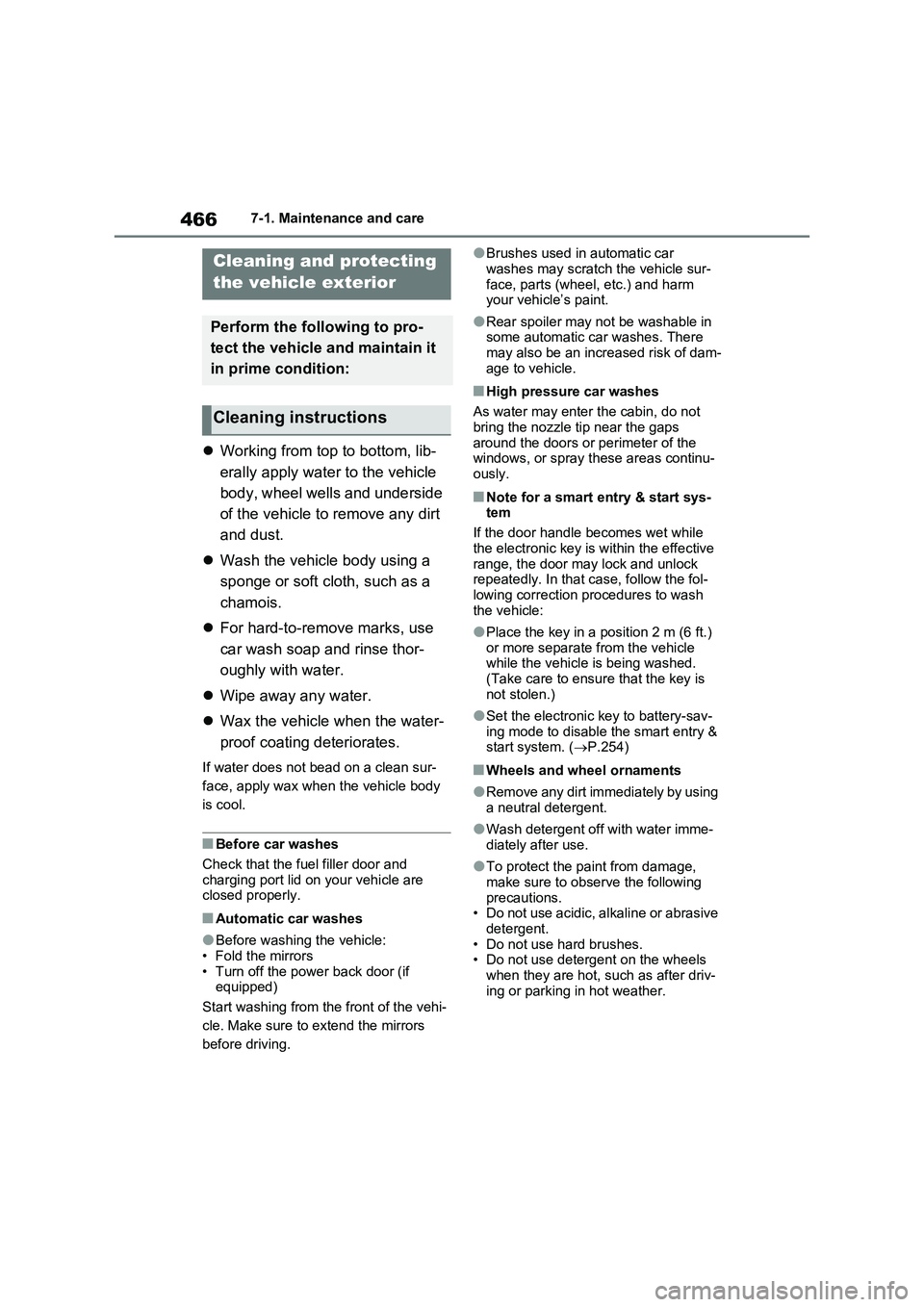
4667-1. Maintenance and care
7-1.Mainte nance a nd care
Working from top to bottom, lib-
erally apply water to the vehicle
body, wheel wells and underside
of the vehicle to remove any dirt
and dust.
Wash the vehicle body using a
sponge or soft cloth, such as a
chamois.
For hard-to-remove marks, use
car wash soap and rinse thor-
oughly with water.
Wipe away any water.
Wax the vehicle when the water-
proof coating deteriorates.
If water does not bead on a clean sur-
face, apply wax when the vehicle body
is cool.
■Before car washes
Check that the fuel filler door and
charging port lid on your vehicle are
closed properly.
■Automatic car washes
●Before washing the vehicle:
• Fold the mirrors
• Turn off the power back door (if
equipped)
Start washing from the front of the vehi-
cle. Make sure to extend the mirrors
before driving.
●Brushes used in automatic car
washes may scratch the vehicle sur-
face, parts (wheel, etc.) and harm
your vehicle’s paint.
●Rear spoiler may not be washable in
some automatic car washes. There
may also be an increased risk of dam-
age to vehicle.
■High pressure car washes
As water may enter the cabin, do not
bring the nozzle tip near the gaps
around the doors or perimeter of the
windows, or spray these areas continu-
ously.
■Note for a smart entry & start sys-
tem
If the door handle becomes wet while
the electronic key is within the effective
range, the door may lock and unlock
repeatedly. In that case, follow the fol-
lowing correction procedures to wash
the vehicle:
●Place the key in a position 2 m (6 ft.)
or more separate from the vehicle
while the vehicle is being washed.
(Take care to ensure that the key is
not stolen.)
●Set the electronic key to battery-sav-
ing mode to disable the smart entry &
start system. (P.254)
■Wheels and wheel ornaments
●Remove any dirt immediately by using
a neutral detergent.
●Wash detergent off with water imme-
diately after use.
●To protect the paint from damage,
make sure to observe the following
precautions.
• Do not use acidic, alkaline or abrasive
detergent.
• Do not use hard brushes.
• Do not use detergent on the wheels
when they are hot, such as after driv-
ing or parking in hot weather.
Cleaning and protecting
the vehicle exterior
Perform the following to pro-
tect the vehicle and maintain it
in prime condition:
Cleaning instructions
Page 469 of 718

467
7
7-1. Maintenance and care
Maintenance and care
■Front side windows water-repel-
lent coating (except quarter win- dow)
●The following precautions can extend the effectiveness of the water-repel-lent coating.
• Remove any dirt, etc., from the front side windows regularly.• Do not allow dirt and dust to accumu-
late on the windows for a long period. Clean the windows with a soft, damp cloth as soon as possible.
• Do not use wax or glass cleaners that contain abrasives when cleaning the windows.
• Do not use any metallic objects to remove condensation build up.
■Brake pads and calipers
Rust may form if the vehicle is parked
with wet brake pads or disc rotors, caus- ing them to stick. Before parking the vehicle after it is washed, drive slowly
and apply the brakes several times to dry the parts.
■Bumpers
Do not scrub with abrasive cleaners.
■Plated portions
If dirt cannot be removed, clean the parts as follows:
●Use a soft cloth dampened with an approximately 5% solution of neutral detergent and water to clean the dirt
off.
●Wipe the surface with a dry, soft cloth
to remove any remaining moisture.
●To remove oily deposits, use alcohol
wet wipes or a similar product.
WARNING
■When washing the vehicle
Do not apply water to the inside of the
engine compartment. Doing so may cause the electrical components, etc. to catch fire.
■When cleaning the windshield
Set the wiper switch to off. If the wiper switch is in “AUTO”, the
wipers may operate unexpectedly in the following situations, and may result in hands being caught or other
serious injuries and cause damage to the wiper blades.
Off
“AUTO”
●When the upper part of the wind-
shield where the raindrop sensor is located is touched by hand
●When a wet rag or similar is held close to the raindrop sensor
●If something bumps against the windshield
●If you directly touch the raindrop sensor body or if something bumps
into the raindrop sensor
■Precautions regarding the
exhaust pipes
Exhaust gasses cause the exhaust pipes to become quite hot.
When washing the vehicle, be careful not to touch the pipes until they have cooled sufficiently, as touching hot
exhaust pipes can cause burns.
A
B
Page 470 of 718
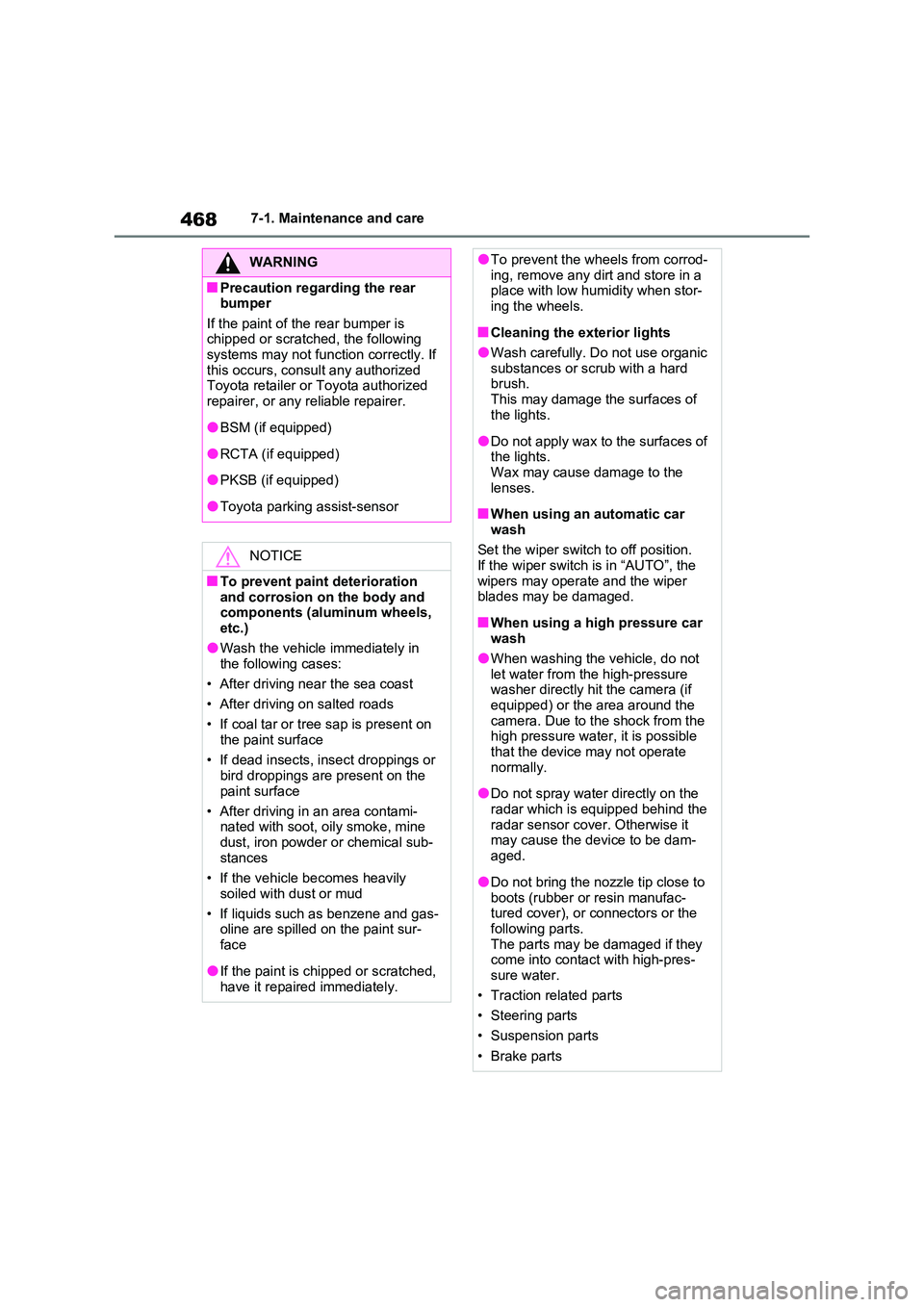
4687-1. Maintenance and care
WARNING
■Precaution regarding the rear bumper
If the paint of the rear bumper is chipped or scratched, the following systems may not function correctly. If
this occurs, consult any authorized Toyota retailer or Toyota authorized repairer, or any reliable repairer.
●BSM (if equipped)
●RCTA (if equipped)
●PKSB (if equipped)
●Toyota parking assist-sensor
NOTICE
■To prevent paint deterioration
and corrosion on the body and components (aluminum wheels, etc.)
●Wash the vehicle immediately in the following cases:
• After driving near the sea coast
• After driving on salted roads
• If coal tar or tree sap is present on
the paint surface
• If dead insects, insect droppings or bird droppings are present on the
paint surface
• After driving in an area contami- nated with soot, oily smoke, mine
dust, iron powder or chemical sub- stances
• If the vehicle becomes heavily
soiled with dust or mud
• If liquids such as benzene and gas- oline are spilled on the paint sur-
face
●If the paint is chipped or scratched,
have it repaired immediately.
●To prevent the wheels from corrod- ing, remove any dirt and store in a place with low humidity when stor-
ing the wheels.
■Cleaning the exterior lights
●Wash carefully. Do not use organic substances or scrub with a hard brush.
This may damage the surfaces of the lights.
●Do not apply wax to the surfaces of the lights.Wax may cause damage to the
lenses.
■When using an automatic car
wash
Set the wiper switch to off position. If the wiper switch is in “AUTO”, the
wipers may operate and the wiper blades may be damaged.
■When using a high pressure car wash
●When washing the vehicle, do not
let water from the high-pressure washer directly hit the camera (if equipped) or the area around the
camera. Due to the shock from the high pressure water, it is possible that the device may not operate
normally.
●Do not spray water directly on the
radar which is equipped behind the radar sensor cover. Otherwise it may cause the device to be dam-
aged.
●Do not bring the nozzle tip close to
boots (rubber or resin manufac- tured cover), or connectors or the following parts.
The parts may be damaged if they come into contact with high-pres-sure water.
• Traction related parts
• Steering parts
• Suspension parts
• Brake parts